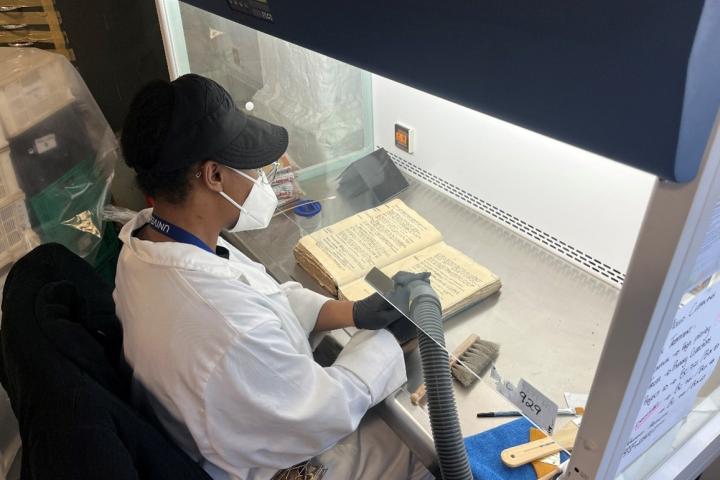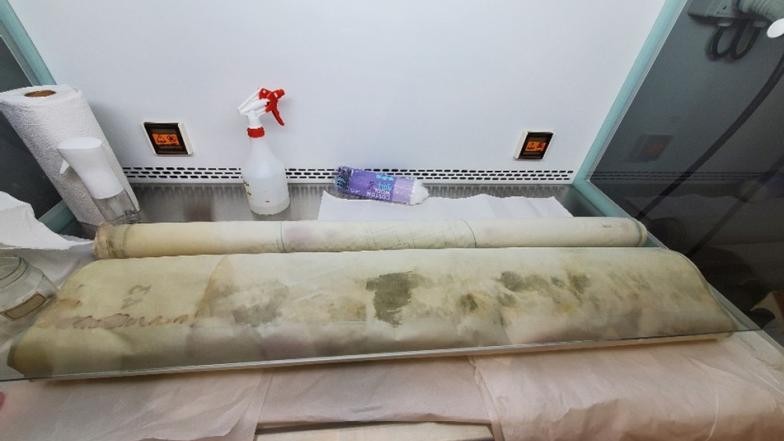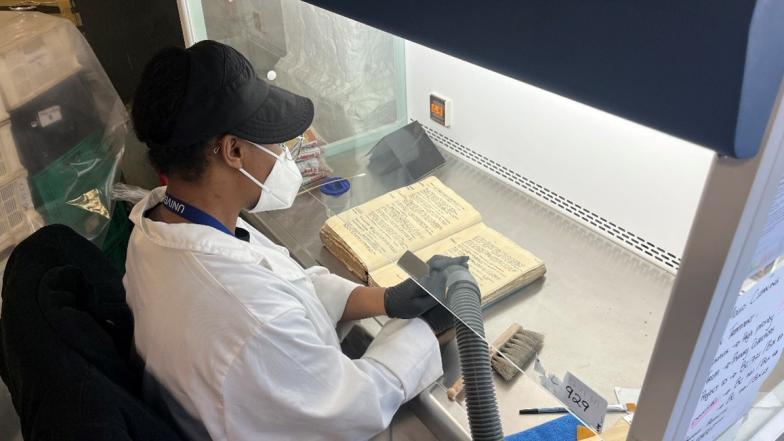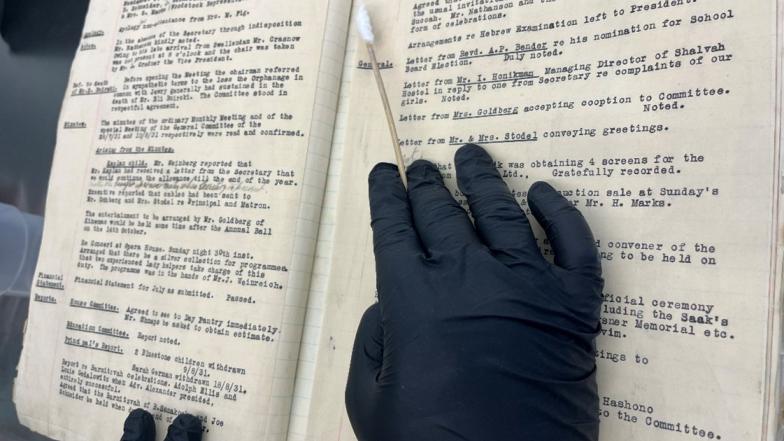Little Dot to Disaster: Mould, Books, and the Art of Preventative Conservation

Maria Candido joined the UCT Libraries conservation unit in May 2025, with experience in conservation and recovery of materials after the Jagger fire. She is focused on the cleaning and repair of objects impacted by mould.
Is That Mould?
It all starts as an innocent little dot on a page.
Combine microscopic mould spores with the perfect environment of damp surfaces, oxygen, organic material and what do you get? A recipe for disaster. Within 24 hours, that tiny dot can turn into a fully contaminated page. Give it two weeks, and an entire book might be consumed by fungus. And just like that, your most treasured piece of literature could be lost to something as small and as sneaky as a speck.
Now, before I scare you away, please remember there is hope.
Why Mould Happens
Finding mould in a library isn’t exactly headline news. When you're working with century-old books, delicate paper, and other organic materials, you're essentially babysitting high-maintenance objects that really don’t like moisture.
And, of course, we’re in the Western Cape -the land of glorious vineyards, dramatic coastlines, and long, wet winters. Our humidity levels can make even a sponge feel dry. So yes, mould happens. It’s not ideal, but it’s also not shocking.
Think of it like catching a cold during flu season: inconvenient, a little gross, but manageable with the right treatment and more importantly, the right prevention.
How the Conservation Unit Helps Mitigate Mould
At our Conservation Unit, we take mould seriously. Our daily monitoring routine includes spot checks and careful tracking of temperature and humidity. These spot checks give us a quick but reliable sense of what’s happening across large collections without needing to inspect every single book.
Using this method, we recently discovered 35 pamphlets at Deneb House showing varying degrees of mould growth. These are now undergoing treatment.
It is worth noting, although it seems routine, these monitoring rounds are essential. Skipping them may not feel urgent in the moment but it’s exactly how small problems become big ones.
Diagnosing the Damage: Mould Categories 1–4
Treatment begins with a thorough assessment of the item. We classify mould damage using a scale from Category 1 (mild) to Category 4 (severe):
Category 1: Light surface mould, removable with dry techniques
Category 2: Moderate surface mould with possible light staining; may require light vacuuming or damp cleaning. The structure of the paper remains intact.
Category 3: Extensive mould growth with staining and odour; moisture may have damaged the fibres of the paper or caused minor warping. Wet cleaning and drying treatments are often needed.
Category 4: Heavy infestation; the paper may be discoloured, or structurally compromised.
Unfortunately, Category 4 items are sometimes beyond repair, where mould has caused permanent loss of material and information. That’s why early detection is crucial.
Isolation, Containment, and Safe Handling
When a mouldy book is found during our daily checks, immediate action is taken namely:
Inspect the surrounding books in the same crate or box
Isolate and bag all affected items
Transfer them to the conservation lab for further treatment
Please note, mould cleaning should only be performed by a professional in a fully equipped lab using proper PPE and protocols. This includes:
Lab coats, gloves, and face masks
HEPA vacuums and smoke sponges
Controlled environmental conditions, including temperature and humidity regulation
In the Lab: Cleaning and Stabilisation
Our work begins inside a fume hood; this equipment ventilates the air through specialised filters that helps prevent airborne mould spores from spreading. It acts as a protective enclosed space between the conservator and hazardous particles or even chemical used to treat mould.

But while the fume hood protects the environment, the real work is done by hand. Page by page.

We use a range of dry-cleaning tools:
Brushes
Micro fibre cloth
Vacuum with HEPA filter
Smoke sponges
Cotton swabs
If necessary, we follow up with wet cleaning methods. A carefully applied solution of ethanol and water can effectively kill mould while evaporating quickly enough to avoid damage like tide marks or paper warping.

A Controlled Environment: Prevention in Action
To support this work on a broader scale, we’ve recently added two new dehumidifiers to the Special Collections Libraries. This small upgrade has already had a big impact creating a more controlled environment.
This effort is part of preventative conservation that is focused on environmental control that can slow down or avoid deterioration of paper-based materials. In other words, it’s better (and cheaper) to prevent mould than to treat it.
What You Can Do: Everyday Prevention Tips
Whether you're a conservator, researcher, or book lover, here are a few simple steps you can take to help prevent mould:
Keep storage areas well-ventilated
Maintain humidity levels between 45- 55%
Promptly fix leaks in walls, ceilings, or plumbing
Avoid storing books in damp, dark places like basements or attics
Use dehumidifiers or silica gel packets (those little absorbent sachets used in food and clothing packaging)
And always remember, mould is a biohazard. It can negatively impact your respiratory health. So, if you see something suspicious on your books don’t ignore it.
When in doubt... check us out.